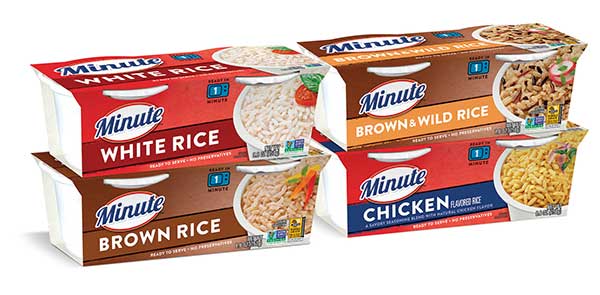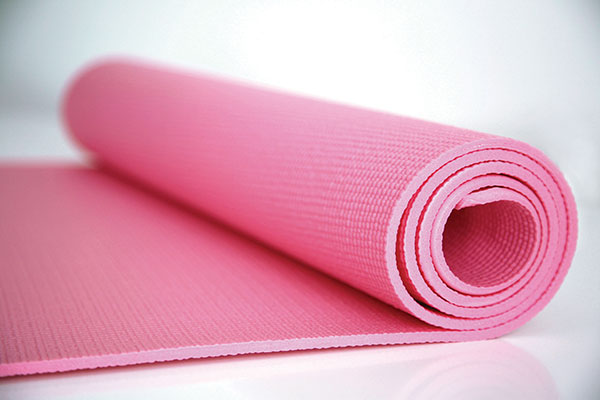HEALTHY LIVING
Make 2022 your year

(Family Features) A new year isn’t just the turning of a calendar page; it’s a new beginning and a perfect opportunity to recommit to yourself. This year, give yourself permission to make your physical and mental wellness a top priority.
Practicing self-care can take many forms, from learning better eating habits to finding ways to enjoy exercise on your own terms. Feeling good physically can influence your mental wellness but remember mindfulness and managing stress are also essential to your overall well-being.
Get a start on new habits and a wellness plan that’s uniquely yours with these products, all created with the idea of making it easier to make better-for-you choices all year long. Find more wellness and lifestyle advice to give yourself a boost in the new year at eLivingtoday.com.

A Convenient, Crunchy Snack
Made from simple, wholesome ingredients that are uncompromisingly delicious, Crunchmaster crackers include ingredients that are always gluten free, dried to a precise moisture and baked for a satisfying crunch to keep you coming back for more. They can be conveniently paired with your favorite dips and toppings for a tasty snack and are perfect for charcuterie when entertaining family and friends. Find more information at Crunchmaster.com.

Eating Better On the Go
Creating quick and easy meals as part of a commitment to eating well in the new year doesn’t have to be difficult. An option like Minute Ready to Serve microwavable cups are perfectly portioned for building on-the-go breakfasts, lunches and snacks that can keep you satisfied and energized throughout the day without overeating. Available in several delicious varieties, including Brown Rice & Quinoa, the non-GMO, gluten-free cups provide just the right amount of carbs for all-day energy and are also MSG free, cholesterol free and contain no preservatives. Learn more at MinuteRice.com.

Join the Viral Proffee Trend
One of the hardest parts of starting and maintaining New Year’s resolutions can be finding great-tasting, nutritious products that can help build healthy habits. This year, try the proffee craze by adding a Premier Protein High Protein Shake to your coffee, latte or cappuccino. It can boost your cup with 30 grams of satiating protein and 24 vitamins and minerals, including antioxidants like vitamins C and E, to help support a healthy immune system. Visit PremierProtein.com for more information.

Strike a Pose to Get in Shape
One advantage of yoga is it can be practiced virtually anywhere. While a mat isn’t strictly necessary, it does help cushion your feet and prevent slipping. If you plan to join a class, loaner mats are generally well-sanitized, but having your own may give you peace of mind. When shopping, remember thinner mats are best for stability-building poses while thicker mats work well for therapeutic sessions. Also consider materials; natural mats are more eco-friendly while PVC mats are easy to clean and more affordable.

Add Audio for a Better Workout
Getting in the right mindset to work out may be easier if you have some motivating music or an intriguing audiobook to listen to instead of counting minutes on the cardio machine. Wireless headphones let you customize your workout experience without affecting anyone who may be nearby. They connect through Bluetooth and eliminate the need to wrestle with a wired connection to your smartphone. There are numerous options (over-ear, on-ear and in-ear) so you can find the style that feels most comfortable and practical for you.
Photos courtesy of Getty Images (woman stretching, yoga mat, headphones)
HEALTHY LIVING
5 travel tips for people with diabetes

(Family Features) Be it a short weekend trip to an epic destination or a longer trip to a dream spot, 212 million American adults are planning much-deserved vacations, according to The Vacationer’s Summer Travel Survey 2024. However, one thing travelers living with type 1 diabetes can’t leave behind: their diabetes.
This is why many frequent travelers living with type 1 diabetes like Nicky Williams, a full-time student who loves documenting travel on her blog, are always prepared by having a checklist when she travels. This checklist helps those like Williams carefully manage type 1 diabetes and allows them to manage the unexpected.
“I was born with a sense of wanderlust,” Williams said. “However, 14 years ago, my ability to travel was challenged when I was diagnosed with type 1 diabetes. Thanks to my diabetes tech, my love for travel and my passion for trying different foods around the world is as strong as ever. When I travel, I’m less stressed‡ when enjoying new cultures and foods where I might not get the carb count just right. I let my MiniMed 780G system do what it does best and account for the unexpected so I can truly immerse myself in the experience instead of my diabetes.”
If you’re planning a trip this summer and looking for a better way to manage your diabetes, consider these tips:
Talk to Your Health Care Provider
Discuss your current treatment plan and any concerns you have. Talk about adjustments you may need to make, depending on where you’re going, what you’ll be doing and how your diet may be affected. Also be sure to get a current letter stating you have diabetes and any special information regarding your needs that you can provide in the event of an emergency.
Pack Your Supplies
Put your diabetes supplies in a carry-on bag and pack twice as much insulin as you think you’ll need. Consider packing insulin with a gel ice pack, which is less likely to get flagged by luggage scanners. With a solution like the Medtronic Extended infusion set, travelers with diabetes have the option for an extended wear duration of up to seven days, leaving more space for packing other items.
Navigate the Airport
Traveling with a medical device or supplies can be a nerve-wracking experience, especially if flying to your destination. Upon arriving at the security screening, notify security officers of any equipment in your carry-on or attached to your body. While you will not be required to remove an attached device, you may be subject to additional screenings, including a visual inspection, self-pat down and other trace testing of the device and supplies.
Research Pharmacies
Look into where you can access additional supplies if you run low, your luggage gets misplaced, or some other unforeseen event affects your insulin or other supplies. Verify whether the pharmacy accepts your insurance and the types of supplies you might need. You may even want to call ahead to get your information entered in their system so they’re able to help you more efficiently if an urgent need arises. If something happens to your insulin pump, know your options for getting a replacement or loaner while traveling.
Safeguard Your Routine
Mealtimes are consistently cited as one of the most difficult aspects of diabetes management and the change of pace that comes with travel and excursions can disrupt your routine. An automated insulin delivery system can help alleviate that stress for those times when you forget to plan ahead. An option such as the MiniMed 780G system has your back if you occasionally forget or miscalculate a dose.† The system’s world-class algorithm measures sugar levels every 5 minutes, assessing if a meal has been eaten and giving automatic corrections and adjustments to insulin. With some of the manual work being taken on by the system, traveling becomes a more seamless experience, allowing you to enjoy your favorite foods, relax and revel in your vacation.
To learn more about managing diabetes on the road, visit medtronicdiabetes.com/TravelTips.

‡ Refers to SmartGuard™ feature. Individual results may vary.
† Taking a bolus 15-20 minutes before a meal helps to keep blood sugar levels under control after eating.
Important safety information: MiniMed™ 780G system with SmartGuard™ technology with Guardian™ 4 sensor
The MiniMed™ 780G system is intended for continuous delivery of basal insulin at selectable rates, and the administration of insulin boluses at selectable amounts for the management of type 1 diabetes mellitus in persons seven years of age and older requiring insulin as well as for the continuous monitoring and trending of glucose levels in the fluid under the skin. The MiniMed™ 780G system includes SmartGuard™ technology, which can be programmed to automatically adjust insulin delivery based on the continuous glucose monitoring (CGM) sensor glucose values and can suspend delivery of insulin when the sensor glucose (SG) value falls below or is predicted to fall below predefined threshold values.
The Medtronic MiniMed™ 780G system consists of the following devices: MiniMed™ 780G insulin pump, the Guardian™ 4 transmitter, the Guardian™ 4 sensor, One-press serter, the Accu-Chek™ Guide Link blood glucose meter, and the Accu-Chek™ Guide test strips. The system requires a prescription from a healthcare professional.
The Guardian™ 4 sensor is intended for use with the MiniMed™ 780G system and the Guardian 4 transmitter to monitor glucose levels for the management of diabetes. The sensor is intended for single use and requires a prescription. The Guardian™ 4 sensor is indicated for up to seven days of continuous use.
The Guardian™ 4 sensor is not intended to be used directly to make therapy adjustments while the MiniMed™ 780G is operating in manual mode. All therapy adjustments in manual mode should be based on measurements obtained using a blood glucose meter and not on values provided by the Guardian™ 4 sensor. The Guardian™ 4 sensor has been studied and is approved for use in patients ages 7 years and older and in the arm insertion site only. Do not use the Guardian™ 4 sensor in the abdomen or other body sites including the buttocks, due to unknown or different performance that could result in hypoglycemia or hyperglycemia.
WARNING: Do not use the SmartGuard™ feature for people who require less than 8 units or more than 250 units of total daily insulin per day. A total daily dose of at least 8 units, but no more than 250 units, is required to operate in the SmartGuard™ feature.
WARNING: Do not use the MiniMed™ 780G system until appropriate training has been received from a healthcare professional. Training is essential to ensure the safe use of the MiniMed™ 780G system.
WARNING: Do not use SG values to make treatment decisions, including delivering a bolus, while the pump is in Manual Mode. When the SmartGuard™ feature is active and you are no longer in Manual Mode, the pump uses an SG value, when available, to calculate a bolus amount. However, if your symptoms do not match the SG value, use a BG meter to confirm the SG value. Failure to confirm glucose levels when your symptoms do not match the SG value can result in the infusion of too much or too little insulin, which may cause hypoglycemia or hyperglycemia.
Pump therapy is not recommended for people whose vision or hearing does not allow for the recognition of pump signals, alerts, or alarms. The safety of the MiniMed™ 780G system has not been studied in pregnant women, persons with type 2 diabetes, or in persons using other anti-hyperglycemic therapies that do not include insulin. For complete details of the system, including product and important safety information such as indications, contraindications, warnings and precautions associated with system and its components, please consult https://www.medtronicdiabetes.com/important-safety-information#minimed-780g and the appropriate user guide at https://www.medtronicdiabetes.com/download-library
Rx Only. Subcut admin of insulin only. NOT for IV or blood products. Infection/irritation risk possible. Follow directions and replace as indicated. See https://bit.ly/infusionsetsafety
Abbreviated+: Rx Only. Subcut admin of insulin only. NOT for IV or blood products. See https://bit.ly/infusionsetsafety
The content and all information provided is for your informational use only and is not intended to be a substitute for professional medical advice, diagnosis, or treatment in any manner. Responses to a treatment may vary from patient to patient. Always talk with your physician about diagnosis and treatment information and ensure that you understand and carefully follow that information.
SOURCE:
Medtronic
HEALTHY LIVING
Combat the epidemic of loneliness by eating together

(Family Features) According to the U.S. Surgeon General, Americans face a lack of social connection that poses a significant risk to individual health and longevity. “Loneliness and social isolation increase the risk for premature death by 26% and 29%, respectively. More broadly, lacking social connection can increase the risk for premature death as much as smoking up to 15 cigarettes a day,” per the report.
One way to address this epidemic of loneliness is by sharing a meal with friends and family. Learn five of the specific advantages of family meals identified by the Family Meals Movement and take advantage of these benefits during National Family Meals Month this September by sharing one more meal together each week.

Meals Together Foster Togetherness and Connectedness
Staying connected can be hard when schedules conflict and life gets busy, but shared meals with friends, family or however you define your family can be the glue that holds people together. Studies demonstrate a positive relationship between family meal frequency and measures of family functioning, which is defined as family connectedness, communication, expressiveness and problem-solving. The key is for family members to engage in conversation with one another during mealtimes and take advantage of the one-on-one time without distractions or interruptions from smartphones or other devices.
Meals Together Strengthen Mental Health
An often overlooked benefit of family meals is mental health support. Multiple studies show family meals have long been associated with improving mental health, including reducing symptoms of depression, decreasing violent behavior and lessening thoughts of suicide among youth. Among adolescents, frequent family meals can help mitigate the risks of destructive behaviors by boosting prosocial behaviors and life satisfaction. Data from the FMI Foundation’s “Staying Strong with Family Meals” Barometer shows family meals also help restore a sense of peace, with one-third of survey respondents saying family meals make them feel calm. In short, family meals are a recipe for strengthening emotional well-being among children and adolescents.
Meals Together Improve Nutrition
There is one easy way to help ensure your family is eating fruits and vegetables: a family meal. Research shows family meals improve fruit and vegetable consumption. It also pays to start this trend early, with research finding preschool-aged children who eat frequent family meals are more likely to eat more fruits and vegetables. Overall, researchindicates families who eat together frequently have a better overall healthy diet and lower body mass index.
Meals Together Improve Academic Performance
Helping students’ academic performance begins around the family dinner table. Eating more meals together as a family is associated with improved overall adolescent health, including higher grades. Multiple studies show students whose families eat together frequently perform better academically in areas such as reading and vocabulary. Research also supports a correlation between frequent family meals lowering incidents of risky and harmful behaviors, including drug and alcohol abuse, which may also contribute to school performance.
Meals Together Teach Civility
The family dinner table is a perfect place to show younger generations how to communicate respectfully, according to the Family Meals Barometer summary. In fact, 76% of survey participants agreed family meals are a good opportunity to have and teach respectful interactions while 70% said frequent family meals create a safe environment for families to discuss thornier societal issues. Another 68% affirmed their belief that sitting at a meal together tends to keep conversations more civil.
Learn more about the physical, mental and social benefits of family meals at familymealsmovement.org and follow #familymealsmonth and #familymealsmovement on social media.
Photo courtesy of Shutterstock
SOURCE:
FMI Foundation
HEALTHY LIVING
Everyday Ways to Nurture Your Skin This Summer: 4 simple habits to support healthy skin

(Family Features) Good skin care doesn’t have to mean intensive routines or expensive moisturizers – it can be as easy as adopting everyday habits that nurture your skin from the inside out. Keeping your skin healthy and glowing begins with protecting it from harmful ultraviolet (UV) rays and eating and drinking healthy foods and beverages.
With an important role in maintaining overall well-being, it’s reassuring to know skin health may be supported with healthy, everyday foods including fresh, juicy grapes. In fact, emerging research suggests consuming grapes may help protect healthy skin even when exposed to UV light, which is known to be damaging. A study published in the journal “Antioxidants,” in which people consumed 2 1/4 cups of grapes every day for two weeks, showed increased resistance to sunburn and reduced markers of UV damage at the cellular level.
This study reinforced previous and similar findings published in the “Journal of the American Academy of Dermatology.” Grapes are also a hydrating food with 82% water content; hydration is essential to healthy skin.
Consider these everyday ways you can protect your skin.
Keep the Sun at Bay
Protecting skin from the sun is crucial. A lifetime of sun exposure can lead to wrinkles, age spots and other health problems, including an increased risk of skin cancer. When you’re out enjoying some sunshine, generously apply sunscreen of at least 30 SPF every 1-2 hours. Covering skin with lightweight, long-sleeve shirts, wide-brimmed hats and other sun-protective clothing can also help block UV rays. Another heat-wave hack: Take to the shade during the hottest parts of the day, usually from 10 a.m. to 4 p.m., to avoid the sun’s rays when they’re at their strongest.
Fill Your Plate with Healthy Foods
Nutritious foods, including fruits and vegetables, can play an important role in achieving an overall balanced diet with adequate hydration. Enjoying the goodness of fresh or frozen Grapes from California can provide extra hydration and a boost of beneficial antioxidants and other polyphenols that help protect the health and function of the body’s cells, including those in the skin.
Stay Hydrated
Drink water throughout the day, and for added flavor, infuse with hydrating fruits like fresh, juicy grapes. For a cool, hydrating snack, try freezing grapes: simply rinse, pat dry, remove from the stems and freeze for 2 hours in a single layer on a sheet pan for flavorful ice cube replacements.
For an easy, refreshing way to add grapes to your menu and stay hydrated on warm days, try these Frozen Grape Lemonade Ice Pops for a sweet, delicious dessert the entire family can enjoy.
Fight Back Against Stress
Stress can negatively impact skin in a variety of ways, including making it more sensitive or reactive. Be mindful of the effects stress can have on your skin and practice stress-relieving techniques like getting enough sleep, exercise and perhaps exploring meditation, deep breathing or yoga.
Visit GrapesFromCalifornia.com for more delicious recipes and information on grapes and health.

Frozen Grape Lemonade Ice Pops
Yield: 8 ice pops
- 2 cups halved California Grapes
- 1 1/3 cups lemonade
- Fill eight 3-ounce ice pop molds with halved grapes.
- Pour in lemonade to just cover fruit. Insert ice pop stick handles.
- Freeze at least 3 hours until frozen.
-

 NEWS2 years ago
NEWS2 years ago2 hurt, 1 jailed after shooting incident north of Nocona
-

 NEWS8 months ago
NEWS8 months agoSuspect indicted, jailed in Tia Hutson murder
-

 NEWS1 year ago
NEWS1 year agoSO investigating possible murder/suicide
-

 NEWS2 years ago
NEWS2 years agoWreck takes the life of BHS teen, 16
-

 NEWS12 months ago
NEWS12 months agoMurder unsolved – 1 year later Tia Hutson’s family angry, frustrated with no arrest
-

 NEWS1 year ago
NEWS1 year agoSheriff’s office called out to infant’s death
-

 NEWS2 years ago
NEWS2 years agoBowie Police face three-hour standoff after possible domestic fight
-

 NEWS2 years ago
NEWS2 years agoDriver stopped by a man running into the street, robbed at knifepoint





